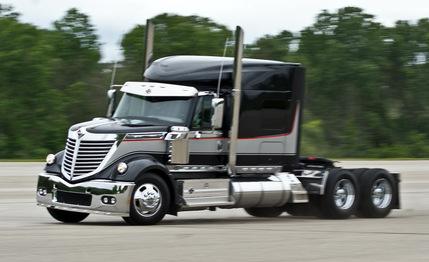
 Road Test
Road Test
Things I did in preparation for driving a big rig: watched Maximum Overdrive (it came highly recommended; I recommend it only to those whose lives seem 97 minutes too long); bought a camouflage hat at a truck stop; checked with the Michigan Secretary of State to confirm that I am legally allowed to drive such a vehicle.
Turns out my Class B commercial driver’s license with air-brake endorsement is sufficient documentation for the authorities, as long as I don’t try to tow more than 10,000 pounds at one time.
When the truck arrives on a Monday morning, it looks like something out of Mad Max—preapocalypse, and if Mad Max had rolled through Sturgis with a giant chrome-attracting magnet. Based on the “regular” and nearly equally showy International LoneStar, this Harley truck is one (actually number two) of 250 that will be built for 2009. It’s a maxed-out, $142,000 LoneStar sleeper cab with 13 grand of Harley appearance added. The cost of the extra swag almost seems reasonable when you consider the thousands of dollars in accessories that Harley bike owners routinely throw at their hogs. The LoneStar’s headlight housings are straight from the Harley catalog, although they use revised innards to meet truck regulations. The huge chrome front bumper is flatter than that of the regular truck and sits below a unique grille. Exhaust-stack heat shields measure a chimneylike seven inches in diameter. Bar-and-shield logos adorn the wheels and the exterior sun visor. Big letters that spell out “Harley-Davidson” are cut into the chrome bands on the sides of the hood. The interior gets Harley emblems on the seats and rear sofa. A special gauge cluster is styled like the pod on the V-Rod motorcycle.
We Were Told the Transmission Would be “Simple.” Riiiiight.
So, yes, it’s a showy truck, but one built to work. Ours had a 15.0-liter Cummins diesel under its clamshell hood, which means each of six cylinders displaces 2.5 liters. The engine is fed air through a massive, leaf-blower-size turbo. Max power of 550 hp is reached only at the engine’s 2000-rpm redline; the monumental 1850 lb-ft of torque peaks practically just off idle, at 1200 rpm. Before reaching the two drive axles at the rear, the power is routed through an 18-speed manual transmission that gives new meaning to “heavy-duty.” In its lowest speed, the transmission restricts you to a maximum velocity similar to that of frozen molasses as it allows the truck to get under way while towing tens of thousands of pounds of same.
This sort of transmission is what keeps just anyone from driving a truck. Although I’ve piloted bigger, heavier, longer, and bendier vehicles (articulated buses, for example), I’ve never had to do so while selecting my own gears.
After a brief walk-around of the truck (wherein we were introduced to the “belly room” specification, which is the space between trucker gut and steering wheel), I kindly asked the driver who delivered the LoneStar for a lesson in shifting the 18 forward ratios, which are really combinations of different cogs that provide 18 discrete “gears.” He said it would be simple once we got used to it. We were skeptical, to say the least.
There are no synchros, which means every shift requires a double-clutch maneuver: clutch in, shift to neutral, clutch out, wait for revs to drop on upshifts or add 200 rpm on downshifts, clutch in, select gear, clutch out. Simple, right? Mess that up, and you’ll be anxiously hunting for a gear that correctly matches the road speed with engine speed, all while the road speed quickly drops off. Haphazard shifter wiggling commences, and the gears make their displeasure heard. Put simply, the transmission hates you and wants you to fail. And I did, several times.
Negotiating the 18-speed shift pattern is a confusing, mind-numbing, who-the-heck-thought-this-made-sense-to-begin-with nightmare. The shift gates are laid out in a dogleg pattern, with low (think of it as gear zero) to the left and down. To the right lie one through four in an H-pattern. From here, the shift pattern follows more of a modified double-helix arrangement. Positions five through eight are the same as one through four but accessed by flicking a switch on the front of the shift knob that chooses among the ranges. Those keeping score at home might notice that that’s only nine speeds. To account for the rest of the ratios, zero through eight are further “split” into low and high, selected by another switch on the left of the shift knob. As a result, there’s a low version of low (or zero) gear found in the lower range. And there are four reverse ratios. No kidding. A diagram on the center console attempts to simplify all of this; we’ve included it in the gallery to confuse you further.
Even the clutch has something to hide. The first few inches of travel provide normal clutch actuation, but go farther down toward the floor, and you hit the clutch brake. Huh? In the absence of synchros, the clutch brake slows or stops the input shaft, which aids smooth and quiet engagement from a standstill. Recalibrating my clutch leg for that was like forgetting how to breathe, or at least trying to do so less frequently. Combine that with the high effort required to depress the clutch pedal, and stopping for a massage at one of those roadside Oriental spas sounded like a good idea. (Wait—it’s not that kind of massage? They do what?)